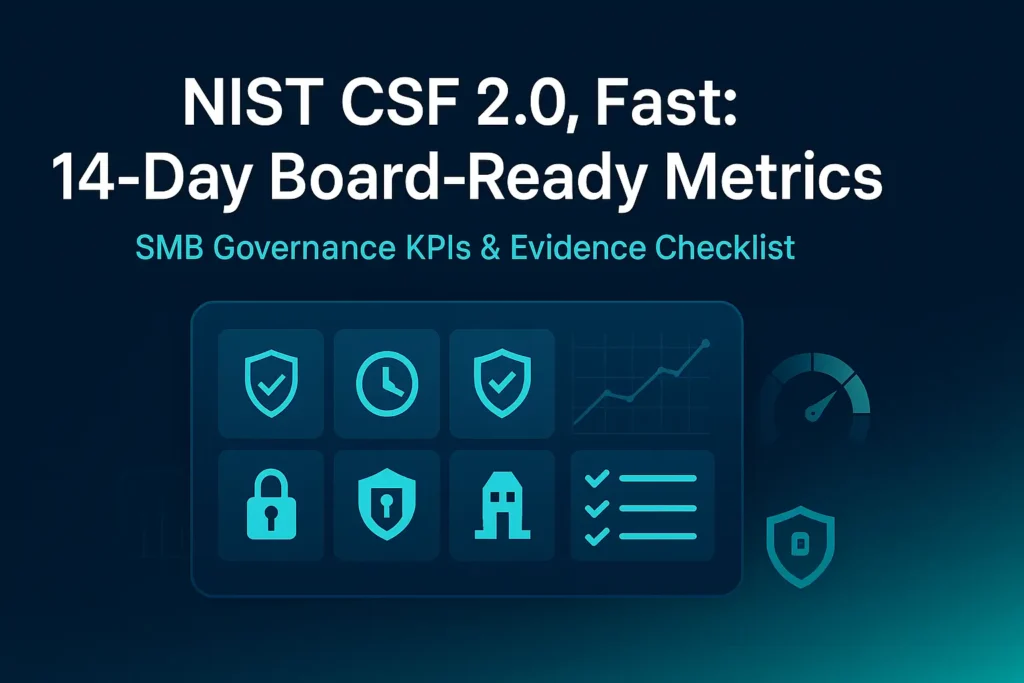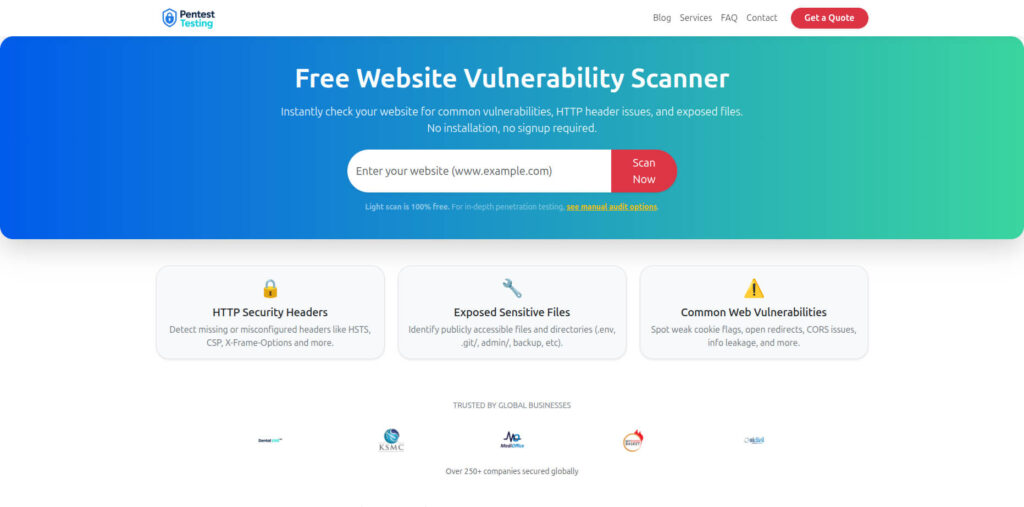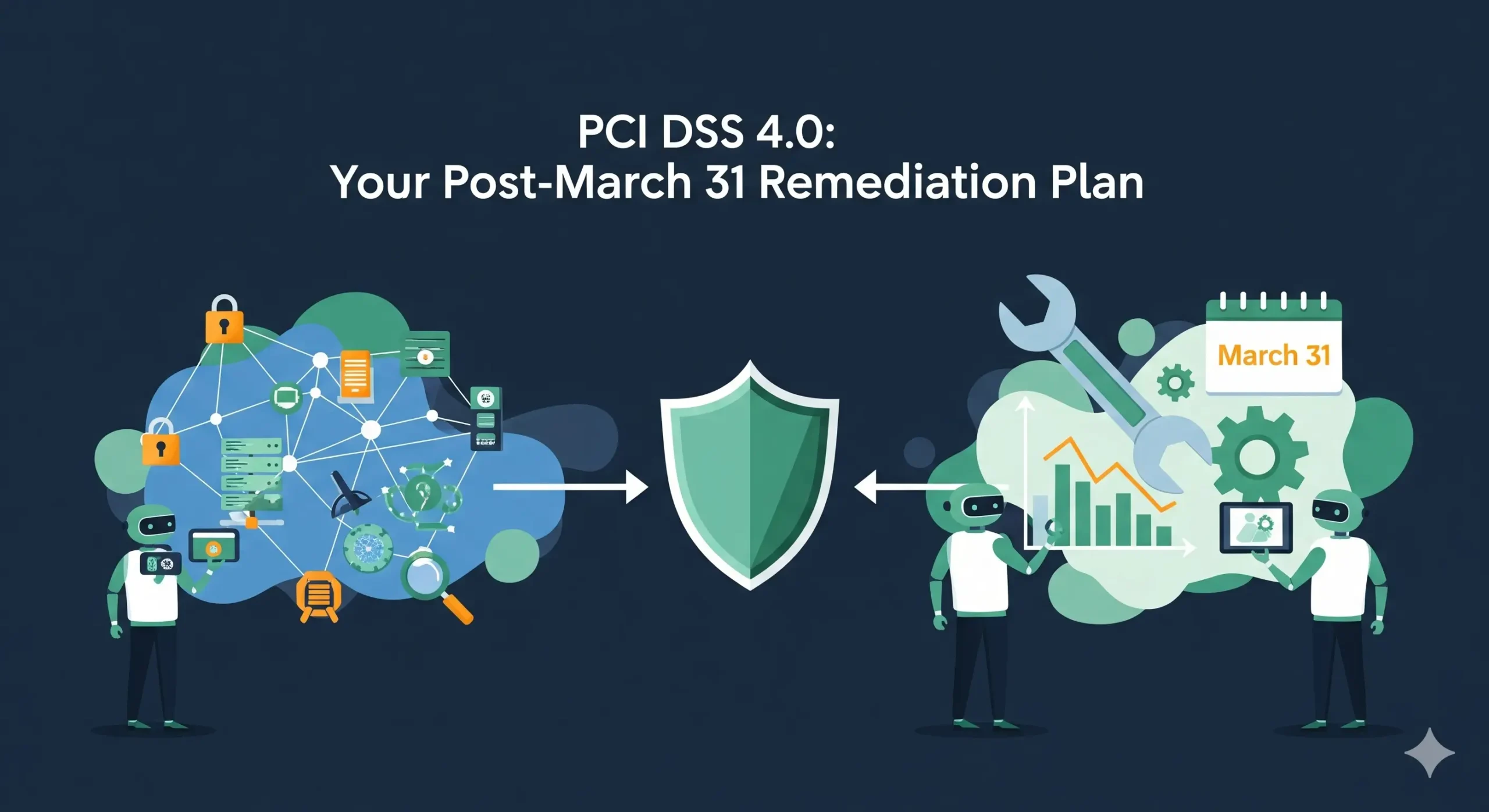NIST CSF 2.0: 14-Day Exclusive Plan for Board-Ready Metrics
If you’re an SMB–midmarket security, risk, or compliance leader, you don’t have months to “theorize” NIST CSF 2.0. You need board-ready governance metrics—fast. This hands-on guide shows how to translate NIST CSF 2.0 Govern outcomes into 6–8 measurable KRIs/KPIs your board actually understands, ship a one-page template with an evidence checklist mapped to Identify/Protect/Detect/Respond/Recover, and automate data collection in two sprints.

Update — Nov 2025: We published a hands-on guide for the Android Security Bulletin November 2025 (zero-click RCE) with a 72-hour fleet plan.
👉 Read the step-by-step playbook
Want the ready-to-use bundle? Get our NIST CSF 2.0 Governance Metrics Pack (templates + evidence checklist) — and we’ll tailor it to your stack.
Outcome: 6–8 Governance KRIs/KPIs the Board Will Actually Use
Below are lean, high-signal metrics that map to NIST CSF 2.0 Govern, avoid jargon, and roll up to executive risk appetite:
- Risk Appetite Status — % of key risks within appetite.
Formula: risks_within_appetite / total_key_risks. - Vulnerability Aging — % of critical vulns older than SLA (e.g., >15 days).
Roll-up: by system owner and crown-jewel tag. - Patch Latency (Median) — days from release → production.
- MFA Coverage — % of workforce & admin accounts with enforced MFA.
- Backup Integrity — % of systems with last successful restore test ≤30 days.
- Incident MTTR — median time from detection → containment.
- Third-Party Risk — % of critical vendors with current assessment & acceptable residual risk.
- Security Control Drift — % of endpoints out of baseline (EDR/MDM/IaC drift).
Tip: Pick 6 that best represent your business risk; keep the rest in an engineering dashboard.
One-Page Metrics Template (Board View)
| Function | Metric | Definition | Target | Data Source | Evidence to Attach |
|---|---|---|---|---|---|
| Identify | Risk Appetite Status | % key risks within appetite | ≥90% | GRC register | Risk register export (CSV), sign-off |
| Identify | Third-Party Risk | % critical vendors assessed | 100% | TPRM tool/Sheets | Latest assessments, remediation plan |
| Protect | MFA Coverage | % users/admins with MFA | 100% admins, ≥98% users | IdP (Okta/AAD) | IdP export, policy screenshot |
| Protect | Patch Latency | Median days release→prod | ≤14 days | Patch/MDM | Patch report, change ticket |
| Detect | EDR Coverage | % endpoints with healthy EDR | ≥98% | EDR console | Agent health export |
| Respond | Incident MTTR | Median detect→contain | ≤4h | IR tickets/SIEM | Timeline, RCA, lessons learned |
| Recover | Backup Integrity | % systems restore-tested | ≥95% | Backup tool | Restore logs, test screenshots |
| Cross-cutting | Vulnerability Aging | % critical > SLA | 0% | VM platform | Aging chart, exception approvals |
Grab this template + an editable version in our pack:
Evidence Checklist (Audit-Grade, Lightweight)
- Policy ↔ Config parity: policy docs, Terraform/IaC, change records
- Console exports: CSV/JSON from IdP, EDR, VM, backup, ticketing
- Screenshots: control settings, successful restore tests, MFA enforcement
- Retest artifacts: before/after scan results, ticket links, timestamps
- Approvals: formal risk acceptance, exceptions with expiry dates
You’ll find a printable version in the Governance Metrics Pack.
14-Day Quick-Start Playbook (Two Sprints)
Sprint 1 (Days 1–7): Baseline & Agree the Scorecard
- Pick 6 metrics, set risk appetite thresholds (e.g., MFA ≥98%, critical vuln aging = 0%).
- Tag crown-jewel systems and critical vendors.
- Export one CSV per source (IdP, VM, EDR, backup, tickets).
- Build the one-page board view and preview it with the COO/CFO.
Sprint 2 (Days 8–14): Automate Evidence & Drill Reporting
- Add small scripts/jobs to auto-collect exports nightly.
- Attach evidence to tickets; generate a weekly PDF/CSV snapshot.
- Run a 30-minute table-top using the new metrics.
- Capture deltas (before/after) and highlight top 3 fixes.
Free Tool Screenshot (Website Vulnerability Scanner):

Use with: Our Free Security Tool
Copy-Paste Code: Real-Time Collection & Roll-ups
These examples are intentionally basic so your team can adapt them to Tenable/Nessus, CrowdStrike/SentinelOne, Jamf/Intune, Okta/AAD, Veeam/Rubrik, Jira/ServiceNow, etc.
1) Risk Appetite & Vulnerability Aging (Python)
import csv, statistics, datetime as dt
CRIT_SLA_DAYS = 15
today = dt.date.today()
with open("vulns.csv") as f:
rows = list(csv.DictReader(f))
def age_days(d):
return (today - dt.datetime.fromisoformat(d).date()).days
crit = [r for r in rows if r["severity"].lower()=="critical" and r["status"]!="Closed"]
aging = [r for r in crit if age_days(r["first_seen"]) > CRIT_SLA_DAYS]
owners = {}
for r in aging:
owners.setdefault(r["owner"], 0)
owners[r["owner"]] += 1
pct_aging = 0 if not crit else round(100*len(aging)/len(crit),1)
median_patch_latency = statistics.median([int(r["patch_latency_days"]) for r in rows if r.get("patch_latency_days")])
print(f"Critical vuln aging >{CRIT_SLA_DAYS}d: {pct_aging}%")
print(f"Median patch latency: {median_patch_latency} days")
print("Top offenders by owner:", sorted(owners.items(), key=lambda x: x[1], reverse=True)[:5])Expected inputs: vulns.csv with columns: severity, status, first_seen, patch_latency_days, owner.
2) MFA Coverage (IdP CSV → KPI) (Python)
import csv
total=admins=with_mfa=0
with open("idp_users.csv") as f:
for u in csv.DictReader(f):
total += 1
if u["is_admin"].lower() == "true":
admins += 1
if u["mfa_enforced"].lower() == "true":
with_mfa += 1
overall = round(100*with_mfa/total,1)
print(f"MFA coverage (overall): {overall}%")
# Admin coverage (separate export or filter)
admins_with_mfa = sum(1 for u in csv.DictReader(open("idp_admins.csv")) if u["mfa_enforced"].lower()=="true")
admin_cov = round(100*admins_with_mfa/admins,1) if admins else 0
print(f"MFA coverage (admins): {admin_cov}%")3) Patch Latency (SQL example)
-- days from vendor_release_date to prod_change_implemented
SELECT
system_owner,
PERCENTILE_CONT(0.5) WITHIN GROUP (ORDER BY DATE_PART('day', prod_change_implemented - vendor_release_date)) AS p50_days,
AVG(DATE_PART('day', prod_change_implemented - vendor_release_date))::INT AS avg_days
FROM patch_calendar
WHERE severity = 'Critical'
GROUP BY system_owner
ORDER BY p50_days ASC;4) Backup Integrity (Bash + JSON)
# Count last successful restore test per system ≤ 30 days
jq -r '.systems[] | "\(.name),\(.last_restore_status),\(.last_restore_date)"' backups.json |
awk -F, -v now="$(date +%s)" '
function tosec(d, cmd){ cmd="date -d \"" d "\" +%s"; cmd | getline t; close(cmd); return t }
{
days=(now-tosec($3))/86400; passed = ($2=="success" && days<=30)
if(passed) ok++ ; total++
}
END { printf("Backup integrity: %.1f%%\n", (ok/total)*100) }'5) Security Control Drift (MDM/EDR export → KPI) (Python)
import csv
total=drift=0
with open("endpoint_health.csv") as f:
for r in csv.DictReader(f):
total += 1
if r["edr_status"]!="healthy" or r["mdm_baseline"]!="compliant":
drift += 1
print(f"Security control drift: {round(100*drift/total,1)}% of endpoints out of baseline")6) Evidence Bundle Collector (Bash)
#!/usr/bin/env bash
set -euo pipefail
STAMP=$(date +%Y%m%d-%H%M%S)
DEST="evidence/$STAMP"; mkdir -p "$DEST"
# Save configs/summaries (examples)
cp /etc/ssh/sshd_config "$DEST/" 2>/dev/null || true
cp /etc/nginx/nginx.conf "$DEST/" 2>/dev/null || true
echo "Okta MFA policy screenshot attached in ticket SEC-123" > "$DEST/notes.txt"
# Hash and zip
( cd "$DEST" && sha256sum * > SHA256SUMS.txt )
zip -r "evidence-bundle-$STAMP.zip" "$DEST"
echo "Evidence bundle created: evidence-bundle-$STAMP.zip"7) Risk Appetite Thresholds (YAML you can track in Git)
risk_appetite:
mfa_users_pct: { target: 98, alert_below: 95 }
mfa_admins_pct: { target: 100, alert_below: 99 }
vuln_critical_aging_pct: { target: 0, alert_above: 0 }
backup_restore_integrity_pct: { target: 95, alert_below: 90 }
patch_latency_p50_days: { target: 14, alert_above: 21 }8) Log Retention & Time Sync (Terraform/Azure CLI)
# Example: retain logs for 365 days
resource "aws_cloudwatch_log_group" "org_trail" {
name = "/aws/cloudtrail/org"
retention_in_days = 365
}# Azure Log Analytics retention to 365 days
az monitor log-analytics workspace update \
-g MyRG -n MyLAW --retention-time 365Sample Report (Metrics Pack to check Website Vulnerability):

What to Show the Board (and Auditors)
- Scorecard first: the one-pager above—trend arrows, red/amber/green, single-sentence context.
- Appendix: automated exports, screenshots, and the zipped evidence bundle.
- Narrative: top 3 risks moving toward/away from appetite; 2-3 “fixes shipped” with proof.
If you’d like a hand aligning your KRIs to your profile, start with a quick workshop:
Recently on our Blog (keep learning)
- 7 Proven Steps for CMMC Level 2 Remediation (2025).
- NIST SP 800-53 5.2: 7 Proven Patch/Update Integrity Fixes.
- 7 Proven Continuous Threat Exposure Management Tactics.
Explore more on the Pentest Testing Corp Blog.
Why This Works for SMB Risk Reporting
- NIST CSF 2.0 alignment without bloat—metrics tie directly to Govern and the five core functions.
- Board-literate language—percentages, time, and coverage beat control IDs.
- Automation-friendly—examples use ubiquitous exports and tiny scripts.
When you’re ready, we’ll plug your stack into our CSF 2.0 Governance Metrics Pack and help your team operationalize it in two sprints.
Start here:
🔐 Frequently Asked Questions (FAQs)
Find answers to commonly asked questions about NIST CSF 2.0.

